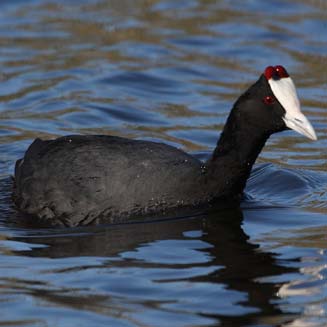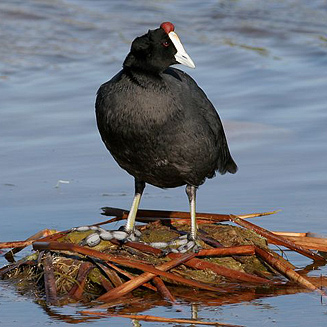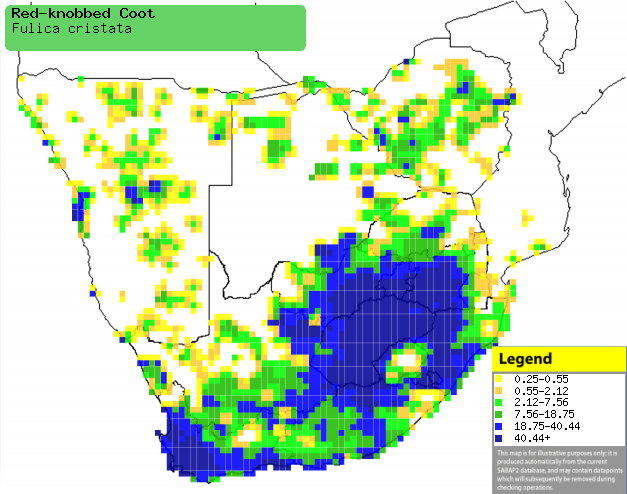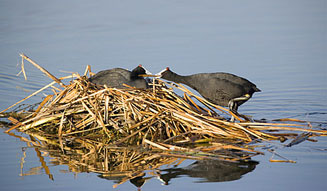|
Fulica cristata (Red-knobbed coot)
Bleshoender [Afrikaans]; Unomkqayi, Unompemvana [Xhosa]; Mohetle,
Mohoetle, Tumu, Boleseboko [South Sotho]; Nhapata (generic name for
coot, gallinule, moorhen, crake or rail) [Shona]; Kukumezani (generic name
for moorhen or coot) [Tsonga]; Kgogonoka [Tswana]; Knobbelmeerkoet
[Dutch]; Foulque à crête [French]; Kammbleßhuhn [German];
Galeirão-de-crista [Portuguese]
Life
> Eukaryotes >
Opisthokonta
> Metazoa (animals) >
Bilateria >
Deuterostomia > Chordata >
Craniata > Vertebrata (vertebrates) > Gnathostomata (jawed
vertebrates) > Teleostomi (teleost fish) > Osteichthyes (bony fish) > Class:
Sarcopterygii (lobe-finned
fish) > Stegocephalia (terrestrial
vertebrates) > Tetrapoda
(four-legged vertebrates) > Reptiliomorpha > Amniota >
Reptilia (reptiles) >
Romeriida > Diapsida > Archosauromorpha > Archosauria >
Dinosauria
(dinosaurs) > Saurischia > Theropoda (bipedal predatory dinosaurs) >
Coelurosauria > Maniraptora > Aves
(birds) > Order: Gruiformes >
Family: Rallidae
 |
 |
| Red-knobbed coot,
Rondevlei Nature Reserve, South Africa. [photo
Duncan Robertson ©]. |
Red-knobbed coot adult at nest,
West Coast National Park, South Africa. [photo Trevor Hardaker ©] |
 |
| Red-knobbed coot, Table View, South
Africa. [photo Trevor Hardaker ©] |
Distribution and habitat
Occurs from southern Spain to Morocco and Algeria, with a
separate population in sub-Saharan Africa. Within southern Africa it is common
in South Africa, also occupying Namibia, northern and south-eastern Botswana,
Zimbabwe and southern Mozambique. It generally prefers freshwater ponds, lakes, vleis,
dams, flood plains, temporary pans, swamps with reeds (Phragmites),
Bulrushes (Typha capensis) and Papyrus (Cyperus papyrus), sewage
ponds and occasionally rivers.
|
 |
|
Distribution of Red-knobbed coot in southern
Africa, based on statistical smoothing of the records from first SA Bird
Atlas Project (©
Animal Demography unit, University of
Cape Town; smoothing by Birgit Erni and Francesca Little). Colours range
from dark blue (most common) through to yellow (least common).
See here for the latest distribution
from the SABAP2. |
Predators and parasites
- Predators
- Parasites
- Rhipicephalus tricuspis (ticks)
- Laemobothrion atrum (bird lice)
Movements and migrations
Mainly nomadic, travelling in response to
rainfall (which creates temporary pans), often taking refuge at
permanent wetlands in drought years.
Food
Mainly eats plant material, supplemented with molluscs,
crustaceans and insects, doing most of its foraging in shallow water, standing
or swimming in search of food on the water surface. The following food items have been recorded
in its diet:
- Plants
- filamentous algae (Chlorophyceae)
- Chara globularis (macroscopic alga)
- Marsilia (aquatic ferns)
- whole plants of Aeschynomene fuitans (knuckle-beans)
- stems, leaves and fruits
- Persicaria limbata (Knotweed)
- Potamagetion pectinatus (Fennel-leaved pondweed)
- stems and leaves
- Najas pectinata (Saw-weed)
- Ruppia maritima (Ditch grass)
- Eichhornia crassipes (Water hyacinth)
- Panicum repens (Torpedo grass)
- leaves
- Paspalum distichum (Couch paspalum)
- Zostera capensis (Cape eelgrass)
- Invertebrates
- molluscs
- Musculus virgiliae (bivalves)
- Gastropods
- crustaceans
- Upogebia africana (Estuarine mudprawn)
Breeding
- Monogamous, territorial solitary nester, breeding cooperatively in small
groups.
- The nest (see image below) is built by both sexes and occasionally
juvenile helpers, consisting of a floating pile of sedge, reed, Bulrush (Typha
capensis) and weed stems, leaves and grass. It is typically placed in
deep water out in the open or among vegetation.
 |
|
|
Red-knobbed coots building their nest, Marievale,
South Africa. [photo Warwick Tarboton ©] |
|
- Egg-laying season is year-round, peaking from about July-November.
- It lays 2-6, rarely up to 11 eggs, which are incubated by both sexes for
about 18-25 days, changing over frequently.
- The chicks leave the nest within a day of hatching and are cared for by
both parents and juvenile helpers. They are divided into groups, each cared
for by one or two adults, eventually fledging at approximately 55-60 days
old.
Threats
Not threatened, in fact it has greatly benefited from the
construction of man-made impoundments, although poisoning (both unintentional
and intentional) is cause for concern.
References
-
Hockey PAR, Dean WRJ and Ryan PG 2005. Roberts
- Birds of southern Africa, VIIth ed. The Trustees of the John Voelcker
Bird Book Fund, Cape Town.
|
